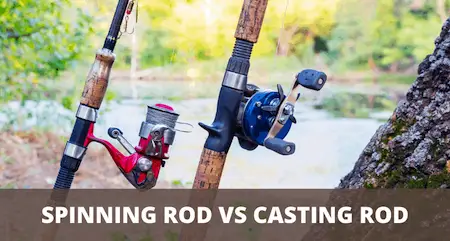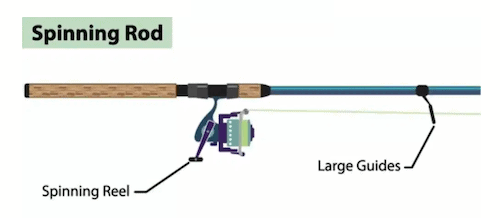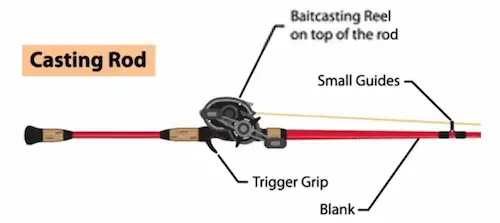Spinning Rod Vs Casting Rod – What Should You Use Each Of Them For?
UPDATED 17 MAY 2023
by Robert Ceran
Spinning rods and casting rods are the two most common types of fishing rods. Combined with their variants (such as surf fishing and trolling rods), they account for more than 90% of the fishing poles in use by anglers.
But many novice anglers are confused by the differences between a casting rod vs spinning rod, and wonder which one they should choose for their specific fishing purpose.
Also, many anglers tend to start their fishing journey using just one type of fishing pole, and after a while they ask themselves if they should be using the other type instead, since it might provide additional advantages.

So in this article we’ll do an in-depth spinning rod vs casting rod comparison, and we’ll also go over their main pros and cons. Finally, we’ll discuss what each is best suited for, and which one is best to choose as a beginner.
What is a spinning rod?

A spinning rod is a type of fishing pole specifically designed to operate with a spinning reel. Its reel seat is located pointing downwards on the rod handle (see Figure above).
And because the reel handle is on the bottom of the rod, the line guides are also located along the bottom of the pole, which puts them on the same side as the reel.
In contrast to its line guides, the backbone (or spine) of a spinning rod runs along the top of the pole.
The spine of a fishing rod is the part that is stiffer, and better equipped to handle the strain when the pole is bent by a big fish. It is always on the side of the blank that points away from the fish.
What is a spinning rod used for?
Spinning rods come in a very wide range of different lengths and sizes, ranging from ultralight graphite poles all the way to heavy fiberglass boat rods.
Because of this diversity in design and size, spinning poles are hands down the most versatile fishing rods used by anglers, and can be adapted for almost any kind of fishing (apart from fly fishing).
The most common use for spinning rods is for casting and retrieving lures, but they are also used for bottom fishing, bobber fishing, live lining, trolling, boat fishing, ice fishing, and surf fishing. In general, spinning poles are used for more lightweight applications than casting poles, though there is a lot of overlap between them.
If you’re into bass fishing, check out our review of the best spinning rod for bass.
What is a casting rod, and what is it used for?

Just like a spinning rod, a casting rod is a type of fishing pole designed to be used with a casting reel (either a baitcasting reel, or a spincast reel).
The reel handle is positioned pointing upwards on top of the rod handle (see Figure above), and the pole backbone plus the line guides are also located running along the top of the rod.
Similar to spinning rods, there is a wide variety of casting pole lengths and sizes, which are used for many different fishing applications. But overall, casting rods tend to be used for more heavy weight applications than spinning poles.
For freshwater angling, the most popular use of casting rods is for casting & retrieving artificial lures, and the majority of bass anglers use them for this purpose.
What is the difference between a spinning and casting rod?
There are 5 main areas of difference between casting and spinning rods, which are summarized in the table below:
| Spinning rod | Casting rod | |
|---|---|---|
| Orientation of reel seat | Pointing downwards on rod handle | Pointing upwards on rod handle |
| Position of line guides | Running along bottom of the rod | Running along top of the rod |
| Size of line guides | Large close to rod handle, getting smaller towards the tip | Small along the whole rod length |
| Number of line guides | Relatively few | Many |
| Location of rod backbone | On opposite side to line guides | On same side as line guides |
Now let’s look at each of these differences in more detail.
Orientation of reel seat: spinning rods are essentially ‘upside down’ compared to casting rods. While their reel seat is designed to hold a spinning reel pointing downwards, the reel seat of a casting pole is designed to hold a baitcasting reel pointing upwards on top of the reel handle.
Position of line guides: while the line guides of a spinning reel run along the bottom of the pole, the guides of a casting pole run along the top. In each case, the line guides are on the same side of the pole as the reel seat.
Size of line guides: the line guides of casting rods are relatively small along the whole length of the rod, while the line guides of spinning poles close to the handle are much larger than those close to the tip.
This wide design of the line guides of a spinning vs casting rod accommodates the wide diameter of the spool of a spinning reel.
In addition, the line guides of spinning rods protrude farther from the pole backbone than those of casting poles, which sit close to the rod.
Number of line guides: spinning rods have fewer line guides that are spaced farther apart than those of casting rods.
Location of rod backbone/spine: as mentioned above, the backbone of a rod is the part of the blank designed to handle most of the strain when the pole bends.
On a spinning pole the backbone runs along the side of the blank opposite to the line guides, while on a casting pole the backbone runs on the same side as the line guides.
In addition to these main distinctions, there are additional smaller differences between a casting vs spinning rod. For example, spinning poles have more taper from base to tip compared to casting poles, which have less taper.
What are the pros and cons of a spinning rod vs baitcasting rod?
So now that we’ve covered the differences, let’s take a look at the advantages and disadvantages of a spinning rod vs casting rod.
Spinning rod advantages:
- Highly versatile, can be used for almost any kind of fishing
- Better suited for lightweight applications (ultralight fishing)
- Easier to master than casting rods
Casting rod advantages:
- Higher casting accuracy
- Greater casting distance
- Works well with bigger lures (e.g. large swimbaits or crankbaits)
- Best choice for heavy applications (big game fishing)
All in all, when comparing the advantages of a spinning rod vs casting rod, it’s safe to say that spinning rods are the most versatile type of fishing pole. Combined with their ease of use, this makes them an ideal choice for beginners.
Casting poles, on the other hand, provide significantly higher casting accuracy (once you know how to master them). This, and the fact that they can be used with heavier fishing lines and lures, makes them ideal for casting lures for bass close to cover, and is the main reason why many bass pros prefer casting poles over spinning poles.
For example, check out our reviews on the best jigging rod for bass, as well as the best topwater rods.
And for a more detailed discussion comparing the types of fishing reels that go with these two pole types, check out the following article: baitcaster vs spinning reel.
Can you use a casting rod or a spinning rod for the same purpose?
The simple answer is yes – both of these rod types can be used for very similar purposes. In fact, the most popular use of both pole types is for throwing & retrieving lures.
This is why we recommend that beginners start their fishing journey with a spinning pole, since it’s much easier to master, while still enabling them to experience many of the same results as with a casting pole.
Having said that, there are some specialized fishing applications that are usually only performed with one of these two pole types.
Most notably, offshore big game rods are practically always casting poles paired with large, powerful conventional reels. Conversely, casting poles are almost never used for ice fishing, which is instead dominated by spinning rods.
Can you use a spinning reel with a casting rod (or vice versa)?
In principle, it’s possible to use a spinning reel on a casting pole, or a baitcasting reel on a spinning pole.
But this is not an ideal solution, since the poles are specifically designed to work best with their respective fishing reel types. Using them with the wrong reel type will always feel awkward and unbalanced, and take the fun of fishing.
In addition, you may even end up breaking the pole due to incorrect use. This is because you have to use the pole in the opposite orientation to which it was intended to be used.
In other words, the pole backbone will be located on the wrong side of the pole when you use it with the wrong reel type, which can lead to breakage when you fight a big fish, or snag your hook on something.
Final remarks
This concludes our spinning rod vs casting rod comparison. Both of them have their own set of strengths and weaknesses, and which one you choose should be guided by your level of experience, plus the specific fishing application you plan to use it for.
